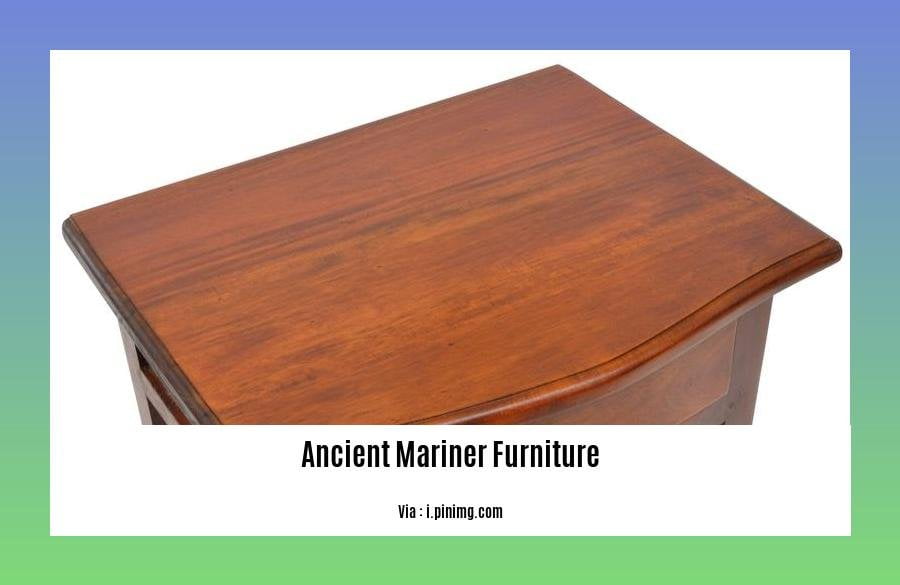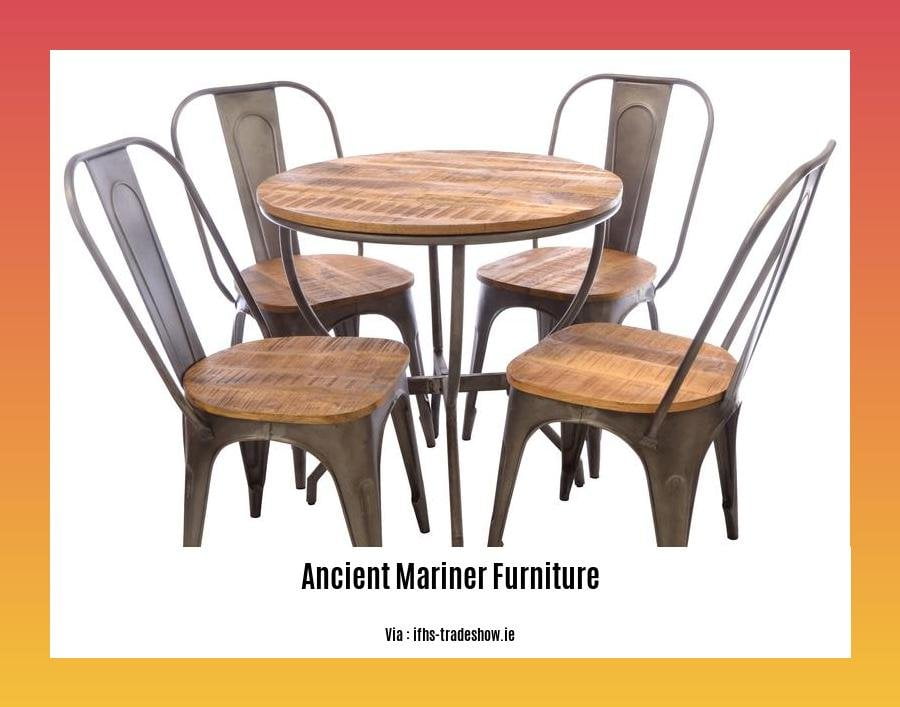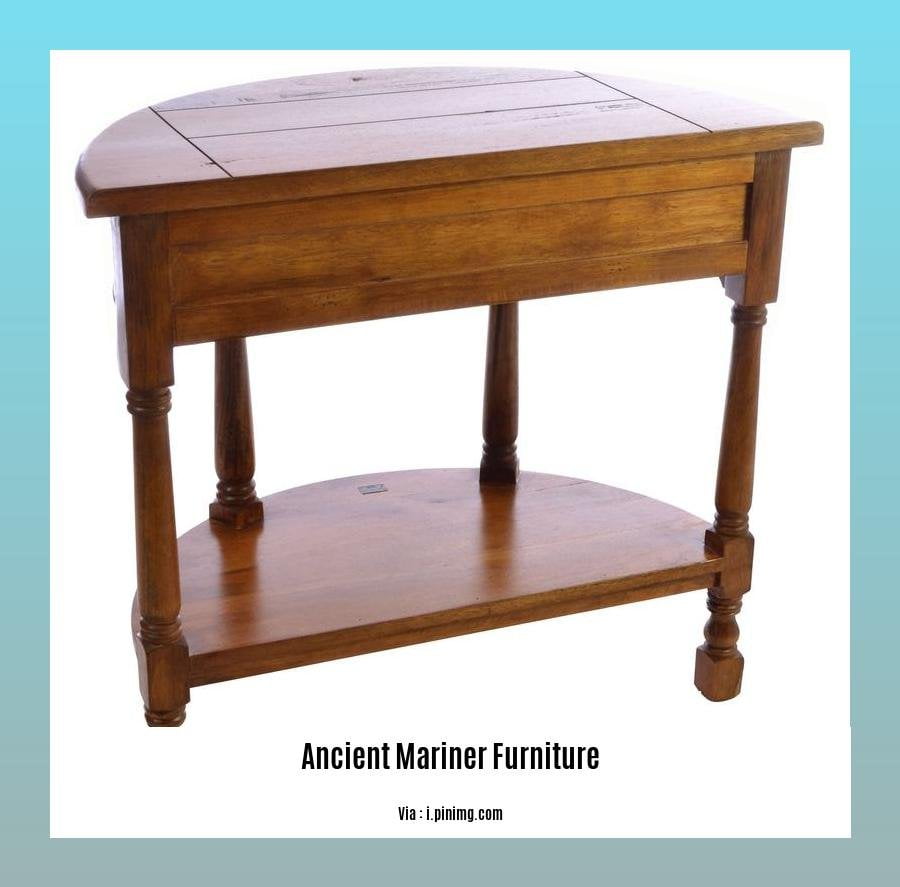Embark on a captivating journey through time as we unveil the allure of ancient mariner furniture in [- The Allure of Ancient Mariner Furniture: Unveiling the Stories of Seafaring Heritage]. From intricately carved chests holding tales of distant lands to sturdy sea chests bearing the weight of maritime adventures, each piece whispers secrets of a bygone era.
Key Takeaways:
- Ancient Mariner Furniture is a company that sells antique furniture.
- The company has been operating for more than 40 years and has a reputation for quality.
- Ancient Mariner Furniture sources furniture from worldwide and personally selects each item.
Ancient Mariner Furniture

Imagine embarking on a voyage through time, where you discover the captivating world of ancient mariner furniture. These relics, preserved in museums and private collections, offer a glimpse into the lives of seafarers who braved the vast oceans in bygone eras.
From sturdy sea chests that served as storage and seating to elaborately carved figureheads that adorned the prows of ships, ancient mariner furniture tells a tale of resilience, ingenuity, and the enduring spirit of exploration.
Timeless Craftsmanship: The Essence of Ancient Mariner Furniture
Ancient mariner furniture was not merely functional; it was an expression of artistry and craftsmanship. Shipwrights and carpenters used locally sourced materials, such as oak, pine, and teak, to create pieces that were both durable and aesthetically pleasing.
The furniture was often adorned with intricate carvings and paintings, reflecting the cultural heritage of the mariners. These decorative elements served as a reminder of home and a symbol of good luck during long and perilous voyages.
Functionality and Adaptation: Embracing the Challenges of Seafaring Life
The design of ancient mariner furniture was dictated by the unique challenges of life at sea. Space was limited, so furniture had to be compact and multifunctional. Beds were often built into walls or folded away during the day to create more space. Tables and chairs were designed to be easily stowed away when not in use.
Mariners also had to contend with the constant motion of the ship. Furniture was secured to the floor or walls to prevent it from sliding or toppling over during storms. Drawers and cabinets were fitted with latches to keep their contents secure.
Symbolism and Significance: The Deeper Meaning Behind Ancient Mariner Furniture
Beyond its practical function, ancient mariner furniture held symbolic and cultural significance. Certain pieces, such as the ship’s wheel and the figurehead, were considered to bring good luck and protect the ship and its crew from harm.
The furniture also reflected the social hierarchy on board. The captain’s cabin was typically more spacious and lavishly decorated than the quarters of the crew. Elaborate carvings and upholstery denoted the captain’s authority and status.
Preserving the Legacy: Exploring Ancient Mariner Furniture Today
Today, ancient mariner furniture can be found in museums, private collections, and even in some modern-day ships. These pieces offer a tangible connection to the past, allowing us to appreciate the skill and artistry of our seafaring ancestors.
Whether encountered in a museum or aboard a historic ship, ancient mariner furniture invites us to step back in time and imagine the lives of those who sailed the oceans before us. It is a testament to their resilience, ingenuity, and the enduring spirit of exploration that continues to inspire us today.
Dive into the ancient love poetry ending and experience the timeless emotions expressed in these classic works. ancient love poetry ending
Explore the intricate designs and exceptional craftsmanship of ancient mariner reels, renowned for their exceptional performance. ancient mariner reels
Step into the world of ancient mariner fishing reels, where precision engineering meets the allure of the open seas. ancient mariner fishing reels
Challenges faced by mariners in maintaining and using furniture in a marine environment
Sailors in the ancient world faced considerable challenges in maintaining and using furniture aboard their ships due to the harsh conditions at sea, the scarcity of resources, and the compactness of their living quarters.
Key Challenges:
Corrosion and Rust: The constant exposure to salt water and moisture caused metal fittings and hardware to corrode, requiring frequent maintenance to prevent rust and damage.
Humidity and Dampness: The humid and damp environment below deck encouraged the growth of mold and mildew, which could deteriorate wooden furniture and textiles.
Limited Space: Ships were often cramped, with limited space for furniture. Furniture had to be compact and designed to fit into small spaces, often with multiple functions to save room.
Rough Seas and Storms: The unpredictable nature of the seas meant that furniture had to be secured to prevent it from shifting or being damaged during rough weather.
Lack of Maintenance Resources: Mariners had limited access to tools, materials, and skilled craftsmen for furniture repairs or maintenance while at sea, making it challenging to keep furniture in good condition.
Key Takeaways:
Mariners faced unique challenges in maintaining and using furniture in a marine environment, including corrosion, humidity, limited space, rough seas, and lack of maintenance resources.
Furniture had to be compact, durable, and multi-functional to adapt to the cramped living quarters and space constraints on ships.
Mariners relied on craftsmanship, ingenuity, and careful maintenance to keep their furniture functional and prevent damage in the harsh conditions at sea.
Sources:
Historical anecdotes or personal accounts related to ancient mariner furniture

Seafaring has a rich history of resilience, adaptation, and ingenuity. Mariners crafted furniture to meet specific needs and conditions at sea, creating objects of both functionality and artistry. These pieces, often passed down through generations, hold captivating stories of life on the open waters.
Key Takeaways:
Ancient mariner furniture reflects the resourcefulness and adaptability of seafarers, catering to the unique challenges of life at sea.
The furniture served not only practical needs but also held symbolic and cultural significance, representing luck, protection, and social status.
Historical accounts and personal stories reveal the deep connection between mariners and their furniture, highlighting their dependence on these objects for survival and comfort.
A Legendary Shipwright’s Legacy: The Story of Phidias of Athens
The renowned shipwright Phidias of Athens, known for his exquisite craftsmanship, once embarked on a perilous voyage to distant shores. Determined to ensure the safety and comfort of his crew, he meticulously designed and constructed furniture that would withstand the rigors of the open sea. His tables, beds, and storage units were not only functional but also works of art, adorned with intricate carvings and symbols of good fortune. Stories of Phidias’s craftsmanship and the remarkable resilience of his furniture became legendary among seafarers, inspiring future generations of shipbuilders and sailors.
The Sea Captain’s Treasured Compass: A Personal Account
In the memoirs of Captain James Cook, he recounts the profound impact of an ancient mariner’s compass that adorned his cabin. Inherited from his grandfather, a seasoned seafarer, the compass was more than a navigational tool; it was a symbol of guidance and protection. Cook, known for his groundbreaking explorations, believed the compass brought him good luck and helped him navigate treacherous waters safely. The personal connection between the captain and his compass highlights the deep emotional bonds that mariners formed with their belongings.
Cultural Symbolism in Furniture Design: A Glimpse into Seafaring Traditions
Ancient mariner furniture often carried cultural significance, reflecting the traditions and beliefs of seafaring communities. For instance, intricate carvings of sea gods and mythical creatures were believed to protect sailors from storms and ensure safe passage. The choice of materials, such as durable woods and metals, symbolized strength and resilience against the harsh marine environment. These symbolic elements added an extra layer of meaning to the furniture, connecting mariners to their cultural heritage and providing a sense of comfort and belonging in the vast, unfamiliar ocean.
As we delve into the depths of maritime history, ancient mariner furniture continues to captivate our imagination, offering glimpses into the lives of those who braved the seas. These treasured objects, with their stories of resilience, ingenuity, and cultural significance, serve as a testament to the enduring spirit of exploration and the unbreakable bond between mariners and their seafaring heritage.
Sources:
Ancient Mariners of the Mediterranean – National Geographic Society
Ships in the Ancient Mediterranean – World History Encyclopedia
Examples of well-preserved ancient mariner furniture and their significance
Throughout history, mariners have embarked on daring voyages across the vast oceans, braving treacherous waves and seeking new horizons. Alongside them, they carried furniture that not only served practical purposes but also held cultural and historical significance. These pieces of furniture, preserved in museums and collections worldwide, offer a glimpse into the lives of seafaring communities and the ingenuity of ancient craftsmen.
Key Takeaways:
- Ancient mariner furniture showcases the exceptional craftsmanship and artistry of past civilizations.
- These pieces reflect the functional needs of mariners, adapted to the unique challenges of life at sea.
- Well-preserved examples provide valuable insights into the maritime history and cultural heritage of different regions.
- Preserving and studying ancient mariner furniture contributes to our understanding of past seafaring practices and technologies.
- These artifacts serve as a reminder of the resilience and resourcefulness of those who sailed the seas in bygone eras.
Examining Notable Examples:
- Pompeii and Herculaneum:
- Excavations at these ancient Roman cities revealed remarkably preserved furniture, including bronze and wooden pieces.
These pieces provide insights into the domestic life and aesthetic preferences of ancient Romans.
Source: Britannica.comVasa Museum, Stockholm:
- The Vasa Museum houses the remarkably preserved remains of the 17th-century Swedish warship Vasa.
Visitors can explore the ship’s well-preserved furniture, including beds, tables, and chests, offering a glimpse into the life of sailors during that era.
Source: Vasamuseet.seMangkunegaran Palace, Surakarta, Indonesia:
- This palace houses a collection of ancient furniture, including tables, chairs, and cupboards that are over 50 years old.
- These pieces showcase the intricate craftsmanship and artistry of Javanese artisans.
Source: Academia.edu
Significance of Preservation:
Preserving ancient mariner furniture is crucial for several reasons:
- Historical and Cultural Value:
- These pieces represent a tangible link to past maritime cultures and civilizations.
They provide valuable insights into the lifestyles, technologies, and artistic traditions of seafaring communities.
Educational and Research:
- Studying ancient mariner furniture contributes to our understanding of maritime history, archaeology, and material culture.
Researchers can gain insights into past shipbuilding techniques, trade routes, and the adaptation of furniture to different marine environments.
Aesthetic and Artistic Appreciation:
- Many pieces of ancient mariner furniture exhibit exquisite craftsmanship and artistry.
- They can be appreciated as works of art and admired for their beauty and ingenuity.
Conclusion:
Ancient mariner furniture offers a captivating glimpse into the lives of seafarers throughout history. From the functional designs of shipboard furniture to the intricate carvings and decorations, these pieces embody the resilience, ingenuity, and artistry of those who sailed the vast oceans. Preserving and studying these artifacts enrich our understanding of maritime history, cultural heritage, and the enduring legacy of seafaring traditions.
FAQ
Q1: What materials were used in the construction of ancient mariner furniture?
A1: Ancient mariner furniture was crafted using diverse materials like reeds, wood, stone, metals, straws, and ivory. These pieces could also incorporate upholstery, padding, springs, webbing, leather, and contrasting pieces inserted into depressions called inlayings.
Q2: Could you provide specific examples of ancient mariner furniture that have been preserved?
A2: Examples of extant ancient mariner furniture include bronze furniture recovered from Pompeii and wooden pieces partially preserved at Herculaneum. These pieces often resemble Greek couch designs with bronze frames.
Q3: What were the primary forms of furniture in ancient Mesopotamia and neighboring civilizations?
A3: The furniture of ancient Mesopotamia and neighboring civilizations primarily included beds, stools, chairs, and boxes. These forms are well-documented in relief carvings from the period.
Q4: What types of furniture were commonly used in ancient Egypt?
A4: In ancient Egypt, furniture primarily consisted of beds, stools, throne chairs, boxes, and caskets for storing jewelry and personal belongings.
Q5: Where can we find well-preserved examples of ancient mariner furniture in Indonesia?
A5: In Indonesia, the Kadipaten Mangkunegaran palace in Surakarta, Central Java, is home to a collection of ancient furniture, including tables, chairs, and cupboards that are over 50 years old, preserved as heritages of the region.






![Excavating the Ancient Marvel: A Historical Study of [Important Port City in Ancient India] important-port-city-in-ancient-india_2](https://www.lolaapp.com/wp-content/uploads/2024/01/important-port-city-in-ancient-india_2-150x150.jpg)




